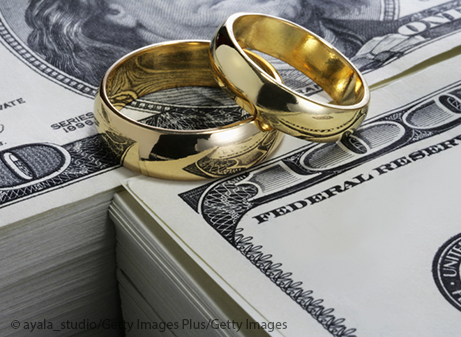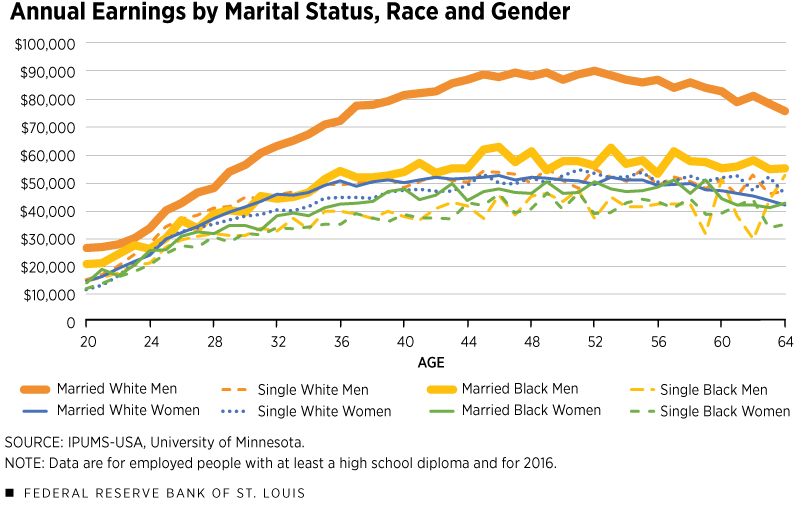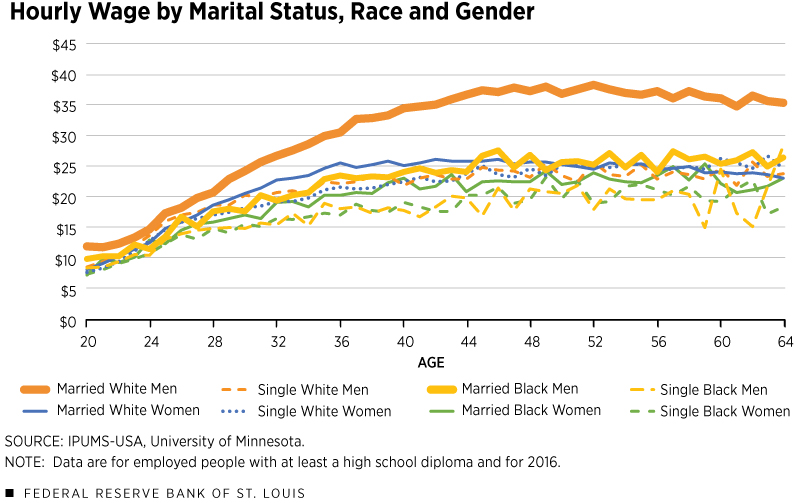Taking a Closer Look at Marital Status and the Earnings Gap

Research suggests that higher earnings of married men account for a significant portion of the gender earnings gap in the U.S. A Regional Economist article took a closer look at this relationship by also examining the earnings gap through the lens of race.
Research Officer and Economist Guillaume Vandenbroucke and former Research Associate Makenzie Peake used 2016 data from the American Community Survey (collected through IPUMS-USA) to examine how marital status affected income for employed people between ages 20 and 64 with at least a high school diploma.
The figure below shows the data by age for Black people and white people, singleThe authors defined “single” as people who have never been married. They did not consider separated, divorced or widowed people in their analysis. and married people, and men and women.

The authors observed that incomes increase with age up to a certain point for all eight demographic groups and that married men—Black and white males—were the highest earners. However, a large disparity existed between married white men and the other groups.
Married white men saw average earnings peak at $90,000 a year, and married Black men (the next-highest earners) experienced peak earnings at $62,000, which is only slightly more on average than the other groups, the authors pointed out.
“A final observation is that single Black men and single Black women earn the least across all groups,” they wrote.
Wages versus Hours Worked
Because earnings are the result of hourly wages and hours worked, Vandenbroucke and Peake looked at whether the higher earnings of married white men might be the result of longer hours worked.
In their analysis, the authors found that married white men did work the longest hours, but the difference was slight, especially when compared with single white men and married Black men.
The authors then looked at average wages for the eight groups of workers. The figure below plots out their average hourly wages.

The authors observed that married white men make significantly more per hour than the other groups, while other groups earn roughly the same amount of money per hour of work.
The Marriage Question
While not offering an explanation for the earnings gap, Vandenbroucke and Peake noted their findings are an attempt to point out a broader area of research and public debate on the question of why married white men earn so much more than everyone else.
“The analysis above shows that even though important differences in earnings among genders and races exist, the true outliers on the earnings scale are more evident by their marital status,” the authors wrote.
They pointed out that this analysis is based on one year during which workers were either single or married, a status that can change during a person’s lifetime. As such, does a change in marital status imply that white males would start to earn more as a result of tying the knot?
“In other words, does marriage make white men more productive? Or could it be that more-productive white men are more likely to marry than less-productive white men?” Vandenbroucke and Peake posed. “Answers to these questions are beyond the scope of this paper, but answering them in the future will be useful for further understanding inequality in the U.S.”
Notes and References
- The authors defined “single” as people who have never been married. They did not consider separated, divorced or widowed people in their analysis.
Additional Resources
- Regional Economist: Observing the Earnings Gap through Marital Status, Race and Gender
- Economic Synopses: Married Men Sit Atop the Wage Ladder
- On the Economy: Will the Gender Pay Gap Get Smaller?
This blog offers commentary, analysis and data from our economists and experts. Views expressed are not necessarily those of the St. Louis Fed or Federal Reserve System.
Email Us
All other blog-related questions


